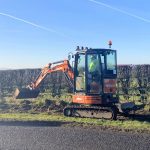Gigaclear CEO Mike Surrey on Building Full Fibre Beyond England
The recently appointed Interim CEO of Oxfordshire-based UK ISP Gigaclear, Mike Surrey, has told ISPreview that they’re ready to grow their Gigabit capable “full fibre” (FTTP/H) rural broadband network beyond England and believe that “market forces driven by competition” will deliver the best outcome.
Anybody familiar with Gigaclear will know that the provider has had quite an eventful couple of years, which recently culminated in Infracapital (M&G Investment Management) acquiring 80% of the business as part of a £270m cash deal (here) and this was later followed by the departure of long-time company CEO and Founder, Matthew Hare (here).
The Infracapital deal means that the ISP has now raised £184m of equity from its shareholders and they have a commitment for a further £150m from Infracapital and Railpen. All of this will be crucial in helping to deliver their rollout plan, which aims to cover 350,000 premises by the end of 2021 (currently at 65,000 premises passed).
Advertisement
Much of the current work stems from their state aid supported contract wins as part of the Government’s wider Broadband Delivery UK programme, which until now has focused on reaching rural parts of 22 counties across England. However Gigaclear’s interim CEO, Mike Surrey, is “confident that we now have the delivery methods and processes to allow us to grow reliably outside of our ‘home’ territory.”
Indeed the ISP has already been linked with a bid on Scotland’s future £600m R100 project (here), which aspires to make “superfast broadband” (30Mbps+) available to 100% of the country by the end of 2021 (March 2022 as a financial year). Similarly we wouldn’t be surprised to see Gigaclear scoop up more contracts in other parts of England and possibly also Wales.
Suffice to say that now is as good a time as any to ask Mike Surrey about Gigaclear’s opinion on the current broadband market and what plans they have for the future.
The Interview
1. Over the past year a multitude of providers have announced plans to significantly invest in major expansions of “full fibre” (FTTH/P) ultrafast broadband infrastructure, which have been partly fuelled by Ofcom’s changes to regulation (e.g. easier access to Openreach’s cable ducts and a revised electronic comms code) and the Government’s support via various funds, as well as a 5 year business rates holiday.
Advertisement
Meanwhile the government has also launched a new consultation, which seeks to understand what kind of future investment and support may be required to help boost FTTP/H and 5G Mobile services. In your opinion, what more must the Government and Ofcom do to further improve the coverage of such services?
ANSWER:
There are around 30 million homes and businesses in the UK. Of these, around 1 million currently have access to full fibre. Gigaclear believes that almost every home and business will need full fibre infrastructure in the future. A build program of this size, to encompass another 29 million properties, will need a regulatory environment that is stable to attract the investment and appear friendly to new linear construction. Whilst Ofcom has been able to influence Openreach to design a better duct and pole sharing model, it still stifles long term investment due to the restrictions on the contracts available.
2. With so many ISPs planning to deploy FTTH/P connectivity into urban areas, the prospect of a significant overbuild will rise. In some areas we might potentially see several FTTH/P providers, which is good for consumer choice but might not improve overall coverage and may frustrate locals if their streets are being dug up multiple times by different operators.
What approach do you think should be taken to this or is it more a matter for natural competition and potentially even future market consolidation to sort out?
ANSWER:
We believe that market forces driven by competition rather than market organisation will deliver a better, if messier, outcome. Some properties will end up having a choice of two or three network infrastructures and some of these are likely to be delivered through combined construction programmes.
3. Gigaclear has successfully won a number of major state aid (Broadband Delivery UK) supported FTTP rollout projects between 2016 and 2018, which should significantly extend the reach of your “full fibre” network over the next few years.
Advertisement
Are you working to win any similar contracts this year and can you tell us anything about the counties or even countries that you have a strong interest in targeting for the future?
ANSWER:
Gigaclear looks at all BDUK opportunities and bids for those where we believe we can deliver a brilliant solution, offering long term returns that are attractive to our shareholders. Because the bidding processes are competitive, we do not comment on specific projects. Although of course you will know that Gigaclear has been announced as shortlisted for the R100 program in Scotland.
4. In keeping with the above, we note that Gigaclear are bidding on the Scotland R100 contract and wondered why it’s taken so long to start seriously considering a move outside of England. What challenges or barriers does Gigaclear face in potentially moving so far away from its base?
ANSWER:
Gigaclear has a regional delivery organisation which manages all our county and regional projects. As we move further from our HQ in Abingdon, the lines of communication are stretched. So, at some point we will need to open regional offices and duplicate some functions in each of them.
Our biggest challenge is building the team and structure to allow us to infiltrate more of rural Britain at scale.
It all takes time and we are keen to make sure we deliver. Inevitably, we do experience hiccups at times, which need to be fixed. However, we are confident that we now have the delivery methods and processes to allow us to grow reliably outside of our ‘home’ territory.
5. The Government’s new Telecoms Infrastructure Review is said to be mulling the controversial old idea of adopting regional franchises, which it’s been claimed could be used to help boost the coverage of “full fibre” broadband, particularly in rural areas.
Under this idea densely populated towns and cities, where the commercial model is easier to make, would be bundled together with swathes of less profitable countryside.
The idea acknowledges that there could be “major hurdles”, such as around the risk of creating new local monopolies, as well as the unclear impact on existing networks (including at wholesale) and the risk of creating a more confusing market for consumers. What are your thoughts on this option?
ANSWER:
This is looking at the age-old question of how to subsidise the non-commercial parts of the build. Fundamentally, you must give a monopoly that allows the monopolist to cross-subsidise the more expensive areas with the less expensive ones. Or you (ultimately taxpayers) provide subsidy directly. Either *can* work.
Continued on page 2..
Mark is a professional technology writer, IT consultant and computer engineer from Dorset (England), he also founded ISPreview in 1999 and enjoys analysing the latest telecoms and broadband developments. Find me on X (Twitter), Mastodon, Facebook, BlueSky, Threads.net and Linkedin.
« Openreach Extend Low Level Error Correction to New 80Mbps FTTC Lines


















































Comments are closed